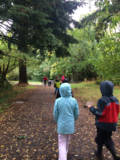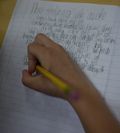Living wide awake

 Tuesday night, I went to a discussion about adolescents and screen-time. The facilitator framed the issue as a battle between the desire to live a life of alertness and connectedness and forces designed to distract and commodify.
Tuesday night, I went to a discussion about adolescents and screen-time. The facilitator framed the issue as a battle between the desire to live a life of alertness and connectedness and forces designed to distract and commodify.
This week, Opal 4 demonstrated its mission to live an engaged life with a walk through Hoyt Arboretum. Hannah invited the class to take this walk “wide awake” with the lens of a writer – even though the rainy day meant that their writer’s notebooks would stay in the dry classroom.
 Children noticed details large and small: a single yellow maple leaf snagged in a Douglas Fir; waxy bulbs in the magnolias; a bird corpse under a willow. They transformed the environment, arranging leaves in various stages of decay into a mandala.
Children noticed details large and small: a single yellow maple leaf snagged in a Douglas Fir; waxy bulbs in the magnolias; a bird corpse under a willow. They transformed the environment, arranging leaves in various stages of decay into a mandala.
NL said that visiting the Arboretum with the lens of a writer makes you, “more focused and you turn into an investigator.” DW said that, “You’re paying a lot more attention to what you’re doing. You’re still playing, but you’re putting everything you do in a little notebook in your brain and remembering everything you do instead of just playing.“
 When they returned, they wrote. CW decided to write under the influence of a Charles Finn essay she read two weeks earlier:
When they returned, they wrote. CW decided to write under the influence of a Charles Finn essay she read two weeks earlier:
Ah, the great smell of fall. Your class is hiking to the Magnolia Grove. You watched the seasons change. Here now is fall. No matter how many years you’ve been alive, I know this one is your favorite. You watch the trees cover the world with a red and yellow blanket. Now, just you and me will watch again as the red and yellow blanket turns white and the first snowman of the year is down.
No, I will not sweep the leaves.
 Today, they applied the language of observational drawing to the experience. Here, too, was an experience that supported being fully awake. MC said, “It would be more perfect if you traced it, but then you’re not really getting to know that leaf.” AM said that you need to, “Draw what you see, not what you know. When you draw what you see with your eyes instead of what you know about it, it always comes out a little different.”
Today, they applied the language of observational drawing to the experience. Here, too, was an experience that supported being fully awake. MC said, “It would be more perfect if you traced it, but then you’re not really getting to know that leaf.” AM said that you need to, “Draw what you see, not what you know. When you draw what you see with your eyes instead of what you know about it, it always comes out a little different.”
All this builds toward our study of the confluence of cultures in our region’s history. Recognizing how we interact with the natural world, what might that interaction have been like for people(s) who lived before us?
At Opal School, even as we live committed to being fully awake – to each other, to the world, to big ideas – we see the Smarter Balanced Assessments coming down the pike. We think about how the strengths and competencies of our students will be narrowed. We recognize that those skills will be measured entirely through computers, a technology almost entirely absent from our school day. We wonder about how we should respond.
How are you fighting the forces of distraction and commodification in your work with children? What challenges – and successes – are you finding in your efforts to be wide awake?

I love this post in so many ways Matt. Ironically I read it for the first time after spending an afternoon in Smarter Balanced Assessment training. The children’s words and your questions give me hope as we forge ahead and look to each other as inspiration for imagining new possibilities.